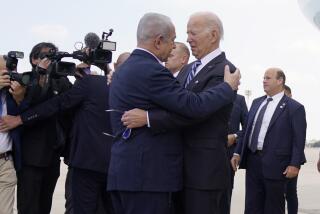Good Move
- Share via
President Reagan’s decision to dismantle two U.S. nuclear submarines to stay under the ceiling on missile launchers imposed by the SALT II treaty was the right one. But it does not mean that Reagan has gone soft on Soviet violations. He wrapped the submarine decision in enough calls for new weapons to make it hard for Moscow to miss seeing the move for what it is: an attempt to prevent the treaty-compliance issue from spoiling the chances of a new and better U.S.-Soviet agreement limiting nuclear forces.
The Senate never ratified the Strategic Arms Limitation Treaty of 1979--partly because of concern over verification problems, but mostly because the political atmosphere turned sour after the Soviet invasion of Afghanistan. Both the U.S. and Soviet governments, however, vowed to abide by the treaty anyway.
The Reagan Administration has since accused the Soviets of extensive violations of SALT II as well as other treaties, ratified and unratified. Some of these accusations are of dubious validity. However, there is one clear violation: an early-warning Soviet radar installation built in a location that violates SALT II. It is also hard to reconcile two other Soviet actions with the treaty--encoding signals radioed back from Soviet missiles during tests and deploying what seems to be one more new Soviet missile than SALT II allows.
One violation alone would confront Reagan with the question of how to respond. The question must be answered now because a new U.S. Trident submarine is ready to go to sea; its 24 missiles will put the United States over SALT II’s limits on missile launchers unless the United States takes two old Poseidon subs out of service or dismantles some land-based Minuteman missiles.
Defense Secretary Caspar W. Weinberger and other ranking Pentagon civilians urged the President to keep the Poseidons in service or in drydock --either of which would violate SALT II.
Reagan wisely rejected the counsel. Aside from the diplomatic flap that would have ensued with America’s allies, keeping the Poseidons in service would cost hundreds of millions of dollars at a time when the military services have better use for the money. It would invite Soviet repudiation of the entire treaty. Keeping the treaty is in the U.S. interest because the Soviets could load many more warheads into their huge missiles if SALT II died.
Fortunately, the President seems to have recognized these realities. A final decision won’t be announced until U.S. allies have been briefed, but reports from Washington that he will decommission the submarines seem solid.
It is still necessary to impress on the Soviets that they pay a price for treaty violations, the highest being a negative effect on negotiations for more comprehensive arms-control agreements.
One way to impress them would be to reconfirm U.S. plans to develop the small, mobile Midgetman missile to match the Soviet SS-25 that is already being deployed. Midgetman would not violate SALT II until it was actually deployed.
Another way would be for both chambers of Congress to approve a bipartisan resolution, by large majorities, putting the Soviets on notice that concern over treaty compliance is widely shared in Congress and is not just a passion of Administration and congressional hard-liners. A number of lawmakers--including Sen. Sam Nunn (D-Ga.), the most influential Democrat on defense matters--have already tried to tell Moscow that failure to recognize the seriousness of the compliance issue could doom a new arms-control treaty to the same fate as SALT II. Congress should say it again.
More to Read
Sign up for Essential California
The most important California stories and recommendations in your inbox every morning.
You may occasionally receive promotional content from the Los Angeles Times.













